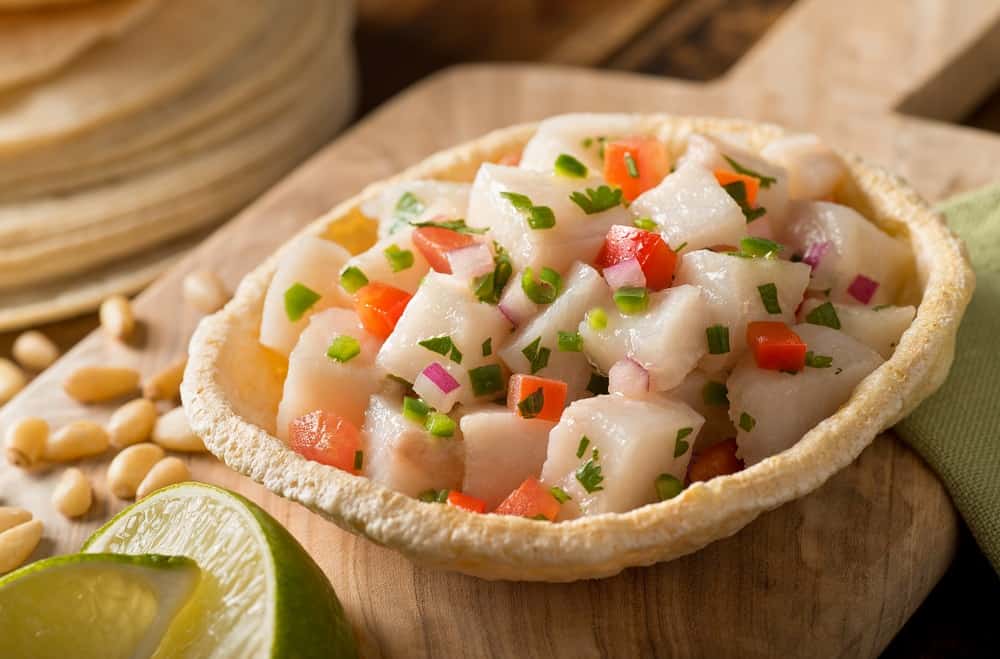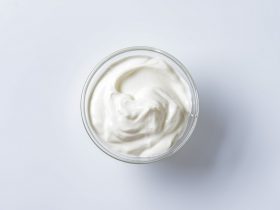When a woman becomes pregnant, it is inevitable that she will have to deal with a lot of information about what food to eat or avoid. During pregnancy, a woman and her fetus have an increased susceptibility to some food-borne diseases with serious sequelae.
Ceviche is a popular fish entrée, using raw fish marinated in citrus juice. Pregnant women should avoid eating ceviche because of its potential to cause food-borne illnesses.
Importance of Eating Fish During Pregnancy
Fish is an important source of essential fatty acids, particularly the omega-6 and omega-3 long chain polyunsaturated fatty acids (PUFA). They contribute to fetal growth and development, and are vital for making cell membranes and new tissues (Nykjaer et al., 2019). Fish is also a good source of vitamin D and selenium (Bosaeus et al., 2015).
Two of the most important omega-3 PUFAs are docosahexaenoic acid (DHA) and eicosapentaenoic acid (EPA). DHA is a vital component of neural and retinal membranes. Both DHA and EPA accumulate in the brain during gestation and even after birth, during the first years of life (Bosaeus et al., 2015).
Essential fatty acids cannot be synthesized in the human body. Therefore, maternal diet consisting of fish is important because the fetus can only derive these essential fatty acids from their mother. These essential fatty acids reach the fetus by crossing the placenta (Nykjaer et al., 2019).
Maternal consumption of PUFAs during pregnancy is associated with a reduced frequency of premature delivery and decreased risk of intrauterine growth restriction and pregnancy induced hypertension (Bosaeus et al., 2015).
Moreover, prenatal exposure of pregnant women to omega-3 long chain fatty acids have been suggested to protect against asthma and allergic diseases in their offspring later in childhood. Stratakis et al. made an analysis in 2017 of pooled data from over sixty thousand mother and child pairs from Europe and US birth cohorts to find evidence for this. They collected information about prevalence of wheezing, asthma and allergic rhinitis during stages of infancy, preschool age and school age. Afterward, they checked fish and seafood consumption of their mothers during pregnancy.
However, results showed that there is no significant association between fish and seafood consumption by pregnant women and respiratory symptoms of asthma and allergic diseases of their children from infancy to mid-childhood (Stratakis et al., 2017).
What is Ceviche?

Ceviche, pronounced as “seh-vee-chay”, is a raw fish entrée. It is a seafood dish where raw fish (or shellfish) is diced into cubes then marinated in lemon or lime juice mixture. The citrus juices “cures” or denatures the fish protein, making the fish firm and absorbing the flavor. It is then served with seasonings, such as onions, cilantro and peppers, and with corn on the cob or sweet potatoes on the side.
The denaturing process changes the proteins of the raw fish. However, it does not eliminate the bacteria or parasites that may be present in it; Raw shellfish is particularly risky and poses a high risk of food poisoning.
Is Ceviche Safe to Eat While Pregnant?
All dishes made out of raw fish and all other raw seafood, including sushi, sashimi, oysters, ceviche and carpaccio, should be avoided during pregnancy. This is because of the threat of food-borne pathogens that come with consumption of raw fish.
Listeria
Listeria can be found in fish from contaminated waters. Contamination of fish can also happen during transportation. The environment of fish markets is also a potential source. Listeria monocytogenes has been isolated from fish and fishery products, as well as other seafood (Jamali et al., 2015).
Listeriosis is a severe food-borne illness that is more likely to affect populations such as pregnant women. Pregnant women have 10 to 20 times increased likelihood of getting this disease, compared to the general population, caused by a downregulation of cellular immunity. The infection can be passed on from the pregnant mother to her unborn fetus through transplacental transmission (Moran et al., 2018).
Listeriosis can result in serious complications, such as miscarriage, premature delivery, maternal and neonatal sepsis, and neonatal death. Cases that are related to pregnancy accounts for more than 20 percent of all Listeriosis cases globally. Its overall case fatality rate is almost 15%, including newborn deaths due to immune system insufficiency (Moran et al., 2018).
Contaminated fish and fish products are considered one of the most frequent sources of Listeria and causes of sporadic cases of Listeriosis. Jamali et al. in 2015 documented more than eight hundred samples of raw fish and fish market environments, including samples from the workers’ hands, knives, containers and work surfaces, from the open-air fish markets in Iran. They then tested the samples for possible contamination of Listeria species.
The authors were able to isolate Listeria from more than 20 percent of the raw fish, and almost 8 percent from the fish market environments. They concluded that their study was able to demonstrate evidence of Listeria contamination in raw fish (Jamali et al., 2015).
Group B Streptoccocus
Raw fish consumption was likewise associated with Group B Streptococcal outbreak of infection in Singapore last 2015 to 2016. This was investigated by Chau et al. in their report in 2017 where they found significant contamination of freshwater fish used for raw consumption of a Chinese-style raw fish dish called Yusheng. During the outbreak, severe clinical cases of Group B streptococcal infection had symptoms of meningoencephalitis, bacteremia and septic arthritis.
Group B streptococcus is not always pathogenic. It can be found in approximately 30 percent of healthy adults. It is part of the human commensal gastrointestinal and genitourinary flora. However, it can be acquired by newborn infants from their mothers through the vaginal flora, and is a common cause of neonatal sepsis (Chau et al., 2017).
Clonorchis Sinensis
Clonorchis sinensis is a fish-borne trematode (parasitic liver fluke). It is endemic in Southeast and East Asia, including China, North Vietnam, South Korea and Eastern Russia. Approximately 15 to 20 million are known to have been infected (Vinh et al., 2018).
Consumption of raw, freshwater fish is the main source of infection in humans. Chronic infection with this liver fluke can lead to a variety of liver and bile duct diseases, the most serious of which is cholangiocarcinoma, a generally fatal type of cancer.
Vinh et al. in 2018 made a social network study of 510 residents from North Vietnam. They determined the rate of Clonorchis sinensis infection by doing fecal examination, and found that infection rate led up to almost 35 percent. Increased rates of infection were also found to be significantly associated with consumption of raw fish.
How to Stay Safe Eating Fish While Pregnant
Here are some tips on how to keep yourself safe against potentially harmful seafood dishes:
- Avoid Raw Fish and Shellfish – Sushi, sashimi, ceviche, raw oysters, scallops or clams
- Avoid Refrigerated, Uncooked Seafood – Nova style, kippered, smoked, jerky
- Pay Attention to Local Fish Advisories – Know if your local waters and fish may be contaminated by specific bacteria or parasites
- Cook Seafood Properly – Fish should be cooked until an internal temperature of 145 degrees Fahrenheit (or 63 degrees Celsius) is achieved, or until the fish separates into flakes and appears opaque throughout. Shrimp, lobsters and scallops should be cooked until they become milky white in color. Clams, mussels and oysters should be cooked until their shells open; Any shell that does not open should be discarded.
Conclusion
Ceviche, along with all other raw and undercooked seafood dishes, can be harmful to pregnant women and their unborn offspring. Therefore, they should not be consumed throughout pregnancy. Always consult your physician if you are unsure whether a certain dish that you have eaten or are planning to eat is safe.
References
- Nykjaer, C., Higgs, C., Greenwood, D., Simpson, N., Cade, J., & Alwan, N. (2019). Maternal fatty fish intake prior to and during pregnancy and risks of adverse birth outcomes: Findings from a British cohort. Nutrients 11(3), 643. doi: 10.3390/nu11030643
- Moran, L., Verwiel, Y., Khomami, M., Roseboom, T., & Painter, R. (2018). Nutrition and listeriosis during pregnancy: A systematic review. Journal of Nutritional Science 7, e25. doi: 10.1017/jns.2018.16
- Jamali, H., Paydar, M., Ismail, S., Looi, C. Y., Wong, W. F., Radmehr, B., & Abedini, A. (2015). Prevalence, antimicrobial susceptibility and virulotyping of Listeria species and Listeria monocytogenes isolated from open-air fish markets. BMC Microbiology 15, 144. doi: 10.1186/s12866-015-0476-7
- Stratakis, N., Roumeliotaki, T., Oken, E., Ballester, F., Barros, H., Basterrechea, M., …, & Chatzi, L. (2017). Fish and seafood consumption during pregnancy and the risk of asthma and allergic rhinitis in childhood: A pooled analysis of 18 European and US birth cohorts. International Journal of Epidemiology 46(5), 1465-1477. doi: 10.1093/ije/dyx007
- Bosaeus, M., Hussain, A., Karlsson, T., Andersson, L., Hulthen, L., Svelander, C., …, & Holmang, A. (2015). A randomized longitudinal dietary intervention study during pregnancy: Effects on fish intake, phospholipids, and body composition. Nutritional Journal 14, 1. doi: 10.1186/1475-2891-14-1




